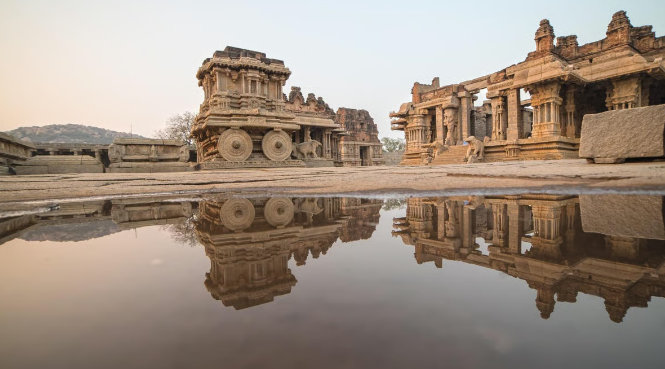Quarrying Threatens Hampi (GS Paper 1, Art & Culture)

Context
- Recently, Hampi, a UNESCO World Heritage Site located in the Vijayanagara district of Karnataka, has faced a new threat: stone quarrying activities in its vicinity.
- This development has alarmed environmentalists and tourists alike, who are concerned about the potential impact on the site’s historical and ecological integrity.
Key Facts About the Vijayanagara Empire and Hampi
Vijayanagara Empire
- Foundation and Origins: The Vijayanagara kingdom, meaning “city of victory,” was established in 1336 by Harihara and Bukka, who had previously served in the army of Muhammad-bin-Tughlaq. They broke away from the Delhi Sultanate to create an independent state in Karnataka, with Vijayanagar as its capital on the banks of the Tungabhadra River.
- Influence: The establishment of the kingdom was significantly influenced by the contemporary scholar and saint Vidyaranya. The empire was ruled by four major dynasties: Sangama, Saluva, Tuluva, and Aravidu.
- Notable Ruler: Krishnadevaraya (1509-29) of the Tuluva dynasty is one of the most renowned rulers. He is also known for composing "Amuktamalyada," a work on statecraft in Telugu.
Hampi
- Historical Significance: Located in Bellary District, Karnataka, Hampi is the site of the Vijayanagara Empire's capital city, which flourished from the 14th to the 16th century CE.
- Architectural Features: Hampi is noted for its distinctive temples with wide chariot streets and pillared mandapas. Prominent structures include the Krishna Temple Complex, Narasimha Temple, Ganesa Temple, Hemakuta Group of Temples, Achyutaraya Temple Complex, Vitthala Temple Complex, Pattabhirama Temple Complex, and the Lotus Mahal Complex.
- UNESCO Status: Hampi was designated a World Heritage Site by UNESCO in 1986, acknowledging its historical and architectural significance.
- Decline: The Vijayanagara Empire fell to a coalition of Deccan sultanates in 1565 (Battle of Talikota), leading to the ruin of Hampi.
Notable Structures in Hampi
- Vittala Temple: Built in the 15th century during the rule of Devaraya II, this temple is dedicated to Vittala (Lord Vishnu) and is also known as Vijaya Vittala Temple. It features a notable stone chariot and musical pillars. The stone chariot is depicted on the Rs 50 currency note.
- Hampi Chariot: Among India’s three famous stone chariots (the other two are in Konark and Mahabalipuram), this 16th-century chariot, ordered by King Krishnadevaraya, is dedicated to Garuda, the official vehicle of Lord Vishnu.
- Virupaksha Temple: A 7th-century Shiva temple dedicated to Lord Virupaksha (Pampapathi), built in the Vijayanagara style of architecture by Lakhan Dandesha under ruler Deva Raya II.
Vijayanagara School of Temple Architecture
- Architectural Diversity: The Vijayanagara architectural style includes a wide range of structures such as temples, monolithic sculptures, palaces, and official buildings. It is characterized by a blend of Hindu and Islamic elements.
- Features: Temples typically feature highly decorative carvings, geometrical patterns, goupurams (gateway towers), and monolithic rock pillars often engraved with mythical creatures like Yali (Horse). Multiple mandapas (pillared halls) were built, with the central one known as Kalyan Mandap. The period also introduced secular buildings within temple premises.
- Notable Structures: Important examples include Mahanavami Tibba, Kalyana Mandapas, and Hazara Ram Temple, with decorative elements featuring horses and grand gateway towers (Raya Gopurams).
Impact of Quarrying
The stone quarrying activities near Hampi pose a grave threat to this historically and ecologically significant site. The quarrying can lead to the following issues:
- Environmental Degradation: Quarrying can cause soil erosion, loss of biodiversity, and disruption of local water systems. These activities can alter the natural landscape, affecting the ecological balance of the region.
- Historical Damage: The removal of stone can potentially damage ancient structures and artifacts, undermining the preservation of the site’s architectural heritage.
- Tourism Impact: The site’s attractiveness to tourists may diminish if quarrying disrupts the scenic and historical integrity of Hampi, affecting local economies dependent on tourism.
Conclusion
- Hampi’s unique historical and architectural heritage, as well as its ecological value, are at significant risk due to ongoing stone quarrying activities.
- The urgency of addressing these threats cannot be overstated. Protecting this UNESCO World Heritage Site requires a concerted effort from both local authorities and international conservation bodies.
- Sustainable measures must be implemented to ensure that Hampi’s historical and environmental legacy is preserved for future generations.
- Enhanced regulatory frameworks and conservation initiatives are essential to mitigate the impact of quarrying and safeguard the rich cultural heritage embodied by Hampi.


